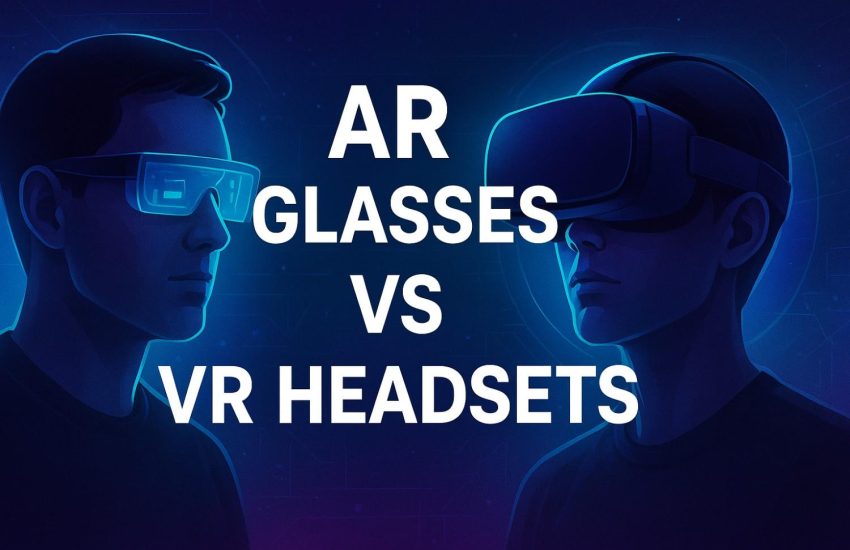The future of immersive technology is unfolding faster than ever. As we move toward 2026, Augmented Reality (AR) glasses and Virtual Reality (VR) headsets are shaping the next generation of digital experiences. Tech giants like Apple, Meta, Microsoft, Google, and Samsung are investing billions in these platforms, creating a race to capture the future of entertainment, business, and everyday life.
But the big question remains: Will AR glasses or VR headsets dominate by 2026? To answer that, we need to explore the key differences, market trends, use cases, and technological advancements driving this competition.
What Are AR Glasses and VR Headsets?
Before comparing them, it’s essential to understand how these technologies differ.
AR Glasses (Augmented Reality)
AR glasses overlay digital information onto the real world. Instead of taking you away from your surroundings, AR enhances what you see by adding virtual elements like navigation instructions, interactive 3D objects, or live translations. Think of Apple Vision Pro, Microsoft HoloLens, or Magic Leap as examples.
Key Features of AR Glasses
- Lightweight and wearable like regular glasses
- Real-world view enhanced with digital data
- Ideal for everyday use, navigation, shopping, healthcare, and gaming
- Strong integration with smartphones and IoT devices
VR Headsets (Virtual Reality)
VR headsets create a completely immersive digital environment, blocking out the physical world. Users experience gaming, entertainment, and training simulations as if they are inside a virtual universe. Popular devices include Meta Quest 3, Sony PlayStation VR2, and HTC Vive.
Key Features of VR Headsets
- Fully immersive experience
- Best for gaming, 3D design, virtual meetings, and entertainment
- Requires dedicated hardware like controllers and sensors
- Focused on creating a parallel digital world
Market Trends Heading Toward 2026
The global market for AR and VR is expected to reach over $250 billion by 2026, with both technologies growing at double-digit annual rates. However, their growth drivers differ:
AR Glasses Market Growth
- Workplace adoption: AR is transforming industries like manufacturing, healthcare, and logistics.
- Consumer applications: Smart AR glasses are expected to replace smartphones in some tasks.
- Hands-free design: AR wearables are becoming lighter, cheaper, and more stylish.
VR Headset Market Growth
- Gaming boom: VR gaming revenue is projected to hit record highs by 2026.
- Metaverse expansion: Companies like Meta are betting big on VR-driven virtual worlds.
- Training & education: VR is increasingly used for medical training, flight simulation, and corporate learning.
Key Insight:
Analysts predict AR glasses will outgrow VR headsets in overall adoption by 2026 because of their practical, everyday applications, while VR will remain dominant in gaming and entertainment.
AR Glasses: The Everyday Tech of the Future
Lightweight Design and Style
Unlike bulky VR headsets, AR glasses are becoming sleeker and more fashionable. Companies like Apple, Samsung, and Xiaomi are focusing on all-day wearability, making AR devices as stylish as traditional eyewear.
Integration with Smartphones and AI
AR glasses are being designed to replace smartphones for tasks like calling, texting, navigation, and social media updates. AI-driven AR assistants will enable real-time translations, facial recognition, and personalized shopping experiences.
Business and Healthcare Use Cases
- Remote Collaboration: Teams can share 3D models and holograms in real time.
- Medical Procedures: Surgeons can access patient data during operations.
- Retail Shopping: AR allows customers to “try on” clothes or furniture virtually.
SEO Keywords: AR glasses 2026, future of augmented reality, smart glasses technology, Apple Vision Pro, AR trends.
VR Headsets: The Ultimate Entertainment Machine
Next-Level Gaming
VR is redefining gaming with ultra-realistic worlds, full-body tracking, and interactive gameplay. By 2026, 6DoF (six degrees of freedom) tracking and wireless headsets will make VR gaming more immersive and affordable.
Virtual Workspaces & Metaverse
Meta, Microsoft, and other tech leaders are investing in VR-powered metaverses, where people can attend virtual meetings, concerts, and events without leaving home.
Training & Education
VR simulations provide safe environments for high-risk training in medicine, aviation, and engineering. Companies and universities are adopting VR to cut costs and improve learning efficiency.
SEO Keywords: VR headsets 2026, future of virtual reality, Meta Quest 3, PlayStation VR2, VR gaming trends.
AR vs VR: Key Differences in 2026
| Feature | AR Glasses | VR Headsets |
|---|---|---|
| Experience | Enhances reality | Fully immersive |
| Hardware | Lightweight, wearable | Bulky, headset required |
| Best Use Cases | Daily life, business, healthcare | Gaming, training, entertainment |
| Adoption Rate | Higher by 2026 | Strong in gaming |
| Price Trend | Becoming affordable | Mid-to-high range |
Key Takeaway:
While VR excels in entertainment and training, AR offers real-world functionality, making it a better fit for everyday use.
Which Will Dominate by 2026?
AR Glasses Will Lead Everyday Adoption
Experts predict that AR glasses will dominate the mainstream market by 2026 because of their practicality, portability, and integration with smartphones and AI. Consumers are more likely to wear AR glasses for navigation, shopping, and work than to use a VR headset daily.
VR Headsets Will Own the Gaming & Entertainment Space
VR will remain the go-to platform for immersive gaming, metaverse experiences, and virtual travel. While AR will reach a wider audience, VR will continue to attract dedicated enthusiasts and gamers.
Final Thoughts
By 2026, AR glasses and VR headsets will coexist, each thriving in different areas.
- AR Glasses will replace smartphones for many tasks, becoming a part of daily life.
- VR Headsets will dominate entertainment, gaming, and professional training.
The real winner will be consumers, who get to experience both worlds—whether it’s exploring the metaverse through a Meta Quest VR headset or navigating the real world with Apple Vision Pro AR glasses.

